LEFT SEPTAL CAPTURE NEAR THE LBB PROVIDES THE SAME LV SYNCHRONY AND LV WORK EFFICIENCY AS DIRECT LBB CAPTURE
Background: Two types of left septal ventricular pacing (LVSP) could be recognized. During the first (general LVSP), LBB capture is not feasible even with the highest pacing output. The second type of LVSP (LVSP near the LBB) occurs during decremental pacing from LBBP.
Objective: To compare electrical ventricular synchrony, acute hemodynamic response, and left ventricular activation between LBBP and LVSP near the LBB in CRT candidates.
Methods: Consecutive CRT patients with LBBB and transition from nsLBBP to LVSP near the LBB during decremental output pacing were included. Ventricular dyssynchrony was assessed using UHF-ECG. The acute hemodynamic response was assessed using a high-precision hemodynamic protocol with invasive measurements of systolic blood pressure. An invasive intracardiac mapping of the left ventricular septum was performed during both captures.
Results: The study included 15 patients. Compared to LBBP, LVSP near the LBB was associated with a longer V6RWPT (98 ± 14 ms vs. 79 ± 13 ms, p < 0.001) and more delayed onset of UHF-ECG ventricular activation (17 ± 4 ms, p < 0.001), and smaller interventricular dyssynchrony (26 ± 12 ms vs. 19 ± 7 ms, p = 0.004). However, no significant difference was observed in LV synchrony (14 ± 6 ms vs. 16 ± 7 ms, p = 0.1) and average systolic blood pressure (121 ± 19 mmHg vs. 122 ± 19 mmHg, p = 0.8). Intracardiac mapping of one patient showed that both LVSP near the LBB and LBBP activated the LV septum via the His–Purkinje system.
Conclusion: In CRT candidates, LVSP near the LBB may serve as an alternative CRT treatment, as it preserves LV septal conduction system activation, LV synchrony, and acute hemodynamic response at the same level as direct LBBP.


